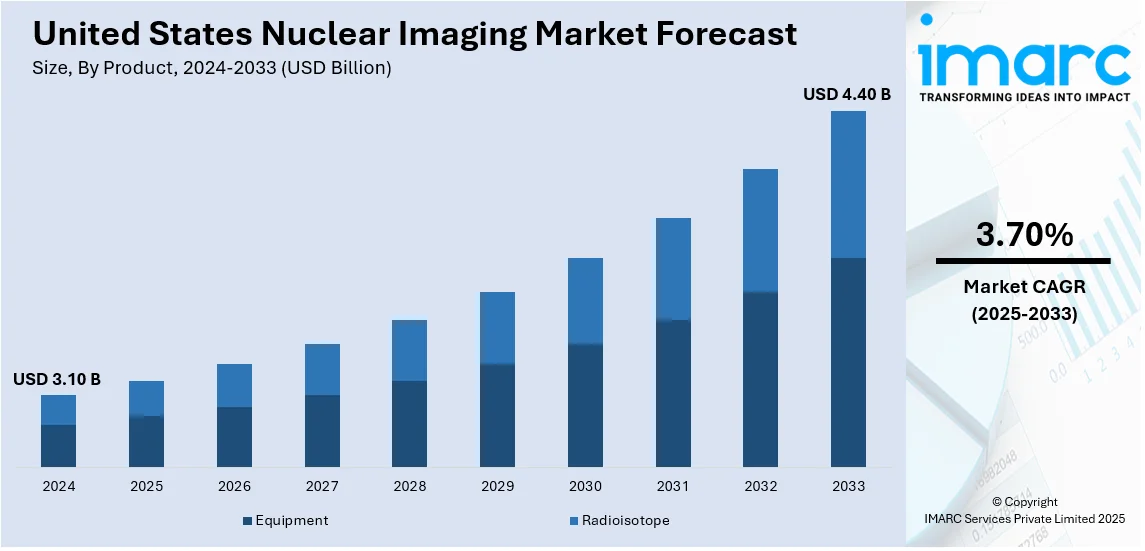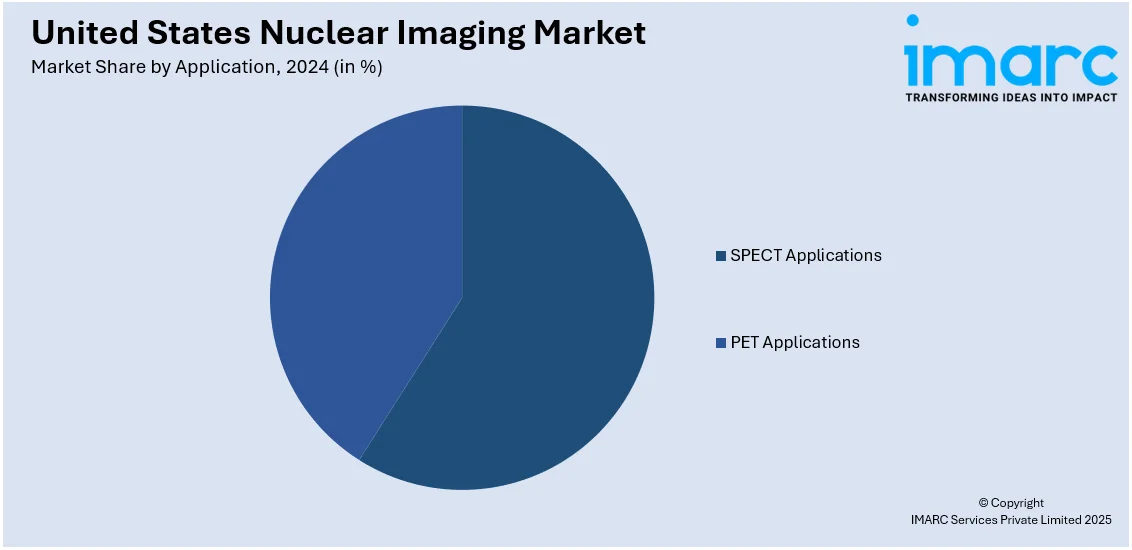
United States Nuclear Imaging Market Size, Share, Trends and Forecast by Product, Application, and Region, 2025-2033
United States Nuclear Imaging Market Overview:
The United States nuclear imaging market size reached USD 3.10 Billion in 2024. Looking forward, IMARC Group expects the market to reach USD 4.40 Billion by 2033, exhibiting a growth rate (CAGR) of 3.70% during 2025-2033. The market is driven by the rising prevalence of chronic diseases including cancer and cardiovascular disorders, increasing adoption of hybrid imaging technologies, and advancements in radiopharmaceuticals for personalized medicine. Additionally, aging populations, FDA support for innovative diagnostics, and AI integration in imaging systems are key factors augmenting United States nuclear imaging market growth.
|
Report Attribute
|
Key Statistics
|
|---|---|
|
Base Year
|
2024 |
|
Forecast Years
|
2025-2033
|
|
Historical Years
|
2019-2024
|
| Market Size in 2024 | USD 3.10 Billion |
| Market Forecast in 2033 | USD 4.40 Billion |
| Market Growth Rate (2025-2033) | 3.70% |
United States Nuclear Imaging Market Analysis:
- Major Market Drivers: The United States nuclear imaging sector is primarily driven by rising chronic disease prevalence, particularly cancer and cardiovascular conditions requiring precise diagnostic imaging. Growing geriatric population demographics, increasing healthcare expenditure, and technological advancements in hybrid imaging systems significantly contribute to expanding market demand and diagnostic capabilities.
- Key Market Trends: The market trends indicate accelerating adoption of artificial intelligence-enhanced imaging systems, personalized radiopharmaceutical therapies, and hybrid PET/CT-SPECT technologies. Integration of theranostic approaches, expanding molecular imaging applications, and increasing focus on precision medicine are transforming diagnostic and therapeutic paradigms within the evolving United States nuclear imaging market share landscape.
- Competitive Landscape: The market features intense competition among established players including GE Healthcare, Cardinal Health, Siemens Healthineers, and emerging radiopharmaceutical companies. Strategic partnerships, technological innovations, FDA approvals, and geographic expansion initiatives characterize competitive dynamics. The market analysis reveals consolidation trends through mergers and acquisitions.
- Challenges and Opportunities: Key challenges include stringent regulatory requirements, high equipment costs, and complex supply chain logistics for radioisotopes. However, significant opportunities exist in expanding theranostic applications, AI-powered diagnostic enhancement, and growing United States nuclear imaging market demand for personalized medicine approaches, creating substantial growth potential for innovative market participants.
United States Nuclear Imaging Market Trends:
Increasing Adoption of Hybrid Imaging Technologies
The market is witnessing a considerable shift toward hybrid imaging technologies including PET/CT and SPECT/CT systems. These advanced modalities also harness the functional imaging prowess of nuclear medicine along with the unrivaled anatomical depth afforded by CT imaging for improved diagnostic accuracy. This drive is fueled by the rise in chronic diseases such as cancer and cardiovascular diseases that require proper diagnosis and follow-up. According to a research report published on February 2024 by the National Center for Chronic Disease Prevention and Health Promotion, about 129 Million Americans have one or more major chronic conditions, of whom 42% have two or more, and 12% have minimum of five. Five of the top 10 leading causes of death are strongly related to preventable and treatable chronic conditions. Chronic diseases account for 90% of the annual USD 4.1 Trillion U.S. health care costs, and their prevalence has been increasing steadily for the past two decades. Additionally, the integration of artificial intelligence (AI) into hybrid imaging systems is improving image analysis, reducing scan times, and minimizing radiation exposure, thereby creating a positive United States nuclear imaging market outlook. Healthcare organizations are increasingly dedicating resources to these innovations to improve patient outcomes and optimize operational efficiency. Increasing demand for hybrid imaging systems to enable timely and accurate diagnosis drives the development of the United States nuclear imaging market trends, as healthcare providers highlight the need for early and precise diagnosis.

To get more information on this market, Request Sample
Rising Demand for Radiopharmaceuticals in Personalized Medicine
The rising demand for radiopharmaceuticals, driven by the growing emphasis on personalized medicine is expanding the United States nuclear imaging market share. Radiopharmaceuticals comprise FDG as well as technetium-based compounds, both of which are critical to targeted diagnostics and targeted treatment (especially in oncology and neurology). The development of novel radiopharmaceuticals, which provide increased specificity and reduced side effects, is further extending their application to precision medicine. On June 24, 2024, Jubilant Radiopharma announced allocating USD 50 Million to establish six new PET radiopharmaceutical manufacturing facilities throughout the United States, thereby increasing its network to a total of 52 sites. This initiative is in response to the rising demand for innovative diagnostic solutions in the fields of cancer and Alzheimer's disease. Moreover, the paced lead for enhancing patient access to radiopharmaceuticals is ushered in through FDA endorsement of intercessions through expedited development and review programs. This demand grows even further when you factor in the aging population, increasing cancer burden, and the prevalence of neurodegenerative disorders. The healthcare industry is increasingly moving toward personalized treatment paradigms, and radiopharmaceuticals are emerging as effective agents for disease detection and management. This trend is anticipated to drive key market growth for nuclear imaging and emphasize the R&D of advanced radiopharmaceuticals within the United States nuclear imaging market analysis framework.
United States Nuclear Imaging Market Segmentation:
IMARC Group provides an analysis of the key trends in each segment of the market, along with forecasts at the region level for 2025-2033. Our report has categorized the market based on product and application.
Product Insights:
- Equipment
- SPECT Radioisotopes
- Technetium-99m (TC-99m)
- Thallium-201 (TI-201)
- Gallium (Ga-67)
- Iodine (I-123)
- Others
- SPECT Radioisotopes
- Radioisotope
- PET Radioisotopes
- Fluorine-18 (F-18)
- Rubidium-82 (RB-82)
- Others
- PET Radioisotopes
The report has provided a detailed breakup and analysis of the market based on the product. This includes equipment [SPECT radioisotopes (technetium-99m, thallium-201, gallium-67, iodine, and others) and radioisotope [PET radioisotopes (fluorine-18, rubidium-82, and others)].
Application Insights:

- SPECT Applications
- Orthopedics
- Thyroid
- Cardiology
- Others
- PET Applications
- Oncology
- Cardiology
- Neurology
- Others
A detailed breakup and analysis of the market based on the application have also been provided in the report. This includes SPECT applications (orthopedics, thyroid, cardiology, and others) and PET applications (oncology, cardiology, neurology, and others).
Regional Insights:
- Northeast
- Midwest
- South
- West
The report has also provided a comprehensive analysis of all the major regional markets, which include Northeast, Midwest, South, and West.
Competitive Landscape:
The market research report has also provided a comprehensive analysis of the competitive landscape. Competitive analysis such as market structure, key player positioning, top winning strategies, competitive dashboard, and company evaluation quadrant has been covered in the report. Also, detailed profiles of all major companies have been provided.
United States Nuclear Imaging Market News:
- In June 2025, GE HealthCare showcased its advanced molecular imaging solutions, including the Flyrcado™ PET myocardial perfusion tracer, at SNMMI in New Orleans. Launched in select U.S. markets the same month, these innovations aim to improve early diagnosis, personalized cardiac treatments, and patient outcomes across the United States.
- In November 2024, United Imaging installed the world’s first uMI Panvivo PET/CT at Pueblo Medical Imaging in Nevada, marking a milestone in U.S. nuclear imaging. The system, featuring AI-driven 3D digital technology and high-resolution imaging, aims to enhance early cancer detection, precision diagnostics, and patient care nationwide.
- October 24, 2024: GE HealthCare initiated the production of its Omni Legend PET/CT scanner in Waukesha, Wisconsin, representing the inaugural manufacturing of this system in the United States. With a total of 100 installations across the country, this AI-driven nuclear imaging technology significantly improves the accuracy of diagnostics and supports personalized medicine.
- October 22, 2024: Telix Pharmaceuticals established Rhine Pharma to enhance nuclear imaging and cancer treatment, utilizing technetium-99m and rhenium-188 isotopes. This initiative comes on the heels of Telix's acquisition of RLS Radiopharmacies for USD 250 million, which broadens its radiopharmaceutical network in the United States to encompass 18 states.
United States Nuclear Imaging Market Report Coverage:
| Report Features | Details |
|---|---|
| Base Year of the Analysis | 2024 |
| Historical Period | 2019-2024 |
| Forecast Period | 2025-2033 |
| Units | Billion USD |
| Scope of the Report |
Exploration of Historical Trends and Market Outlook, Industry Catalysts and Challenges, Segment-Wise Historical and Future Market Assessment:
|
| Products Covered |
|
| Applications Covered |
|
| Regions Covered | Northeast, Midwest, South, West |
| Customization Scope | 10% Free Customization |
| Post-Sale Analyst Support | 10-12 Weeks |
| Delivery Format | PDF and Excel through Email (We can also provide the editable version of the report in PPT/Word format on special request) |
Key Benefits for Stakeholders:
- IMARC’s industry report offers a comprehensive quantitative analysis of various market segments, historical and current market trends, market forecasts, and dynamics of the United States nuclear imaging market from 2019-2033.
- The research report provides the latest information on the market drivers, challenges, and opportunities in the United States nuclear imaging market.
- Porter's five forces analysis assist stakeholders in assessing the impact of new entrants, competitive rivalry, supplier power, buyer power, and the threat of substitution. It helps stakeholders to analyze the level of competition within the United States nuclear imaging industry and its attractiveness.
- Competitive landscape allows stakeholders to understand their competitive environment and provides an insight into the current positions of key players in the market.
Key Questions Answered in This Report
The nuclear imaging market in the United States was valued at USD 3.10 Billion in 2024.
The United States nuclear imaging market is projected to exhibit a CAGR of 3.70% during 2025-2033, reaching a value of USD 4.40 Billion by 2033.
The market is driven by rising prevalence of chronic diseases including cancer and cardiovascular disorders, increasing adoption of hybrid imaging technologies, advancements in radiopharmaceuticals for personalized medicine, aging populations, FDA support for innovative diagnostics, and AI integration in imaging systems enhancing diagnostic accuracy and operational efficiency.
Need more help?
- Speak to our experienced analysts for insights on the current market scenarios.
- Include additional segments and countries to customize the report as per your requirement.
- Gain an unparalleled competitive advantage in your domain by understanding how to utilize the report and positively impacting your operations and revenue.
- For further assistance, please connect with our analysts.
 Request Customization
Request Customization
 Speak to an Analyst
Speak to an Analyst
 Request Brochure
Request Brochure
 Inquire Before Buying
Inquire Before Buying




.webp)




.webp)












